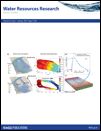Li et al., 2017
Understanding Watershed Hydrogeochemistry: 2. Synchronized Hydrological and Geochemical Processes Drive Stream Chemostatic Behavior
Li Li, Chen Bao, Pamela L. Sullivan, Susan Brantley, Yuning Shi, Chris Duffy (2017)
Water Resources Research, 53(3) 2346–2367
-
Shale Hills, INVESTIGATOR
-
Shale Hills, GRAD STUDENT
-
Calhoun, Shale Hills, INVESTIGATOR, COLLABORATOR
-
National, Eel, Luquillo, Shale Hills, INVESTIGATOR, COLLABORATOR
-
Shale Hills, INVESTIGATOR
-
Shale Hills, INVESTIGATOR
Abstract
Why do solute concentrations in streams remain largely constant while discharge varies by orders of magnitude? We used a new hydrological land surface and reactive transport code, RT-Flux-PIHM, to understand this long-standing puzzle. We focus on the nonreactive chloride (Cl) and reactive magnesium (Mg) in the Susquehanna Shale Hills Critical Zone Observatory (SSHCZO). Simulation results show that stream discharge comes from surface runoff (Qs), soil lateral flow (QL), and deeper groundwater (QG), with QL contributing >70%. In the summer, when high evapotranspiration dries up and disconnects most of the watershed from the stream, Cl is trapped along planar hillslopes. Successive rainfalls connect the watershed and mobilize trapped Cl, which counteracts dilution effects brought about by high water storage (Vw) and maintains chemostasis. Similarly, the synchronous response of clay dissolution rates (Mg source) to hydrological conditions, maintained largely by a relatively constant ratio between “wetted” mineral surface area Aw and Vw, controls Mg chemostatic behavior. Sensitivity analysis indicates that cation exchange plays a secondary role in determining chemostasis compared to clay dissolution, although it does store an order-of-magnitude more Mg on exchange sites than soil water. Model simulations indicate that dilution (concentration decrease with increasing discharge) occurs only when mass influxes from soil lateral flow are negligible (e.g., via having low clay surface area) so that stream discharge is dominated by relatively constant mass fluxes from deep groundwater that are unresponsive to surface hydrological conditions.
Citation
Li Li, Chen Bao, Pamela L. Sullivan, Susan Brantley, Yuning Shi, Chris Duffy (2017): Understanding Watershed Hydrogeochemistry: 2 Synchronized Hydrological and Geochemical Processes Drive Stream Chemostatic Behavior . Water Resources Research, 53(3) 2346–2367. DOI: 10.1002/2016WR018935
 This Paper/Book acknowledges NSF CZO grant support.
This Paper/Book acknowledges NSF CZO grant support.
Explore Further







